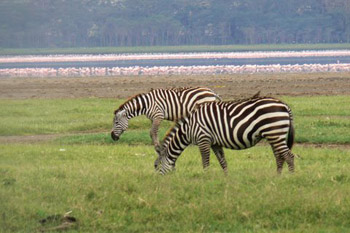
The Hunters and the Hunted
by Arun Bhatia
“Everyone who has a chance to see nearly two million animals on the move has been touched by the magic of this place. What is it that gets under their skin? The urgency of the movement of the wildebeest? The wide open plains? The African light? Or maybe it is the fact that we all came from here, not such a long time ago, and our deep unconsciousness remembers the time, 60,000 generations ago…Or maybe it is just the sheer number of the migrating animals as they move in the world’s last surviving great migration, ” these words, quoted from Markus Borner, Frankfurt Zoo representative in Serengeti, are about the Great Migration.
I had seen it on the Discovery, National Geographic and Animal Planet channels and elsewhere in vivid detail, helicopter shots with multiple cameras by ace photographers wielding the latest gadgets, backed by satellite image experts, ethologists, cartographers and wildlife scientists.
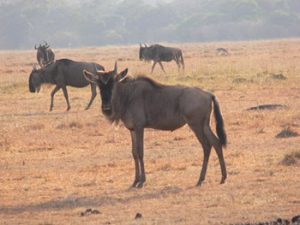 Would watching the migrating wildebeest and zebras live be different? Armed with binoculars and an 8 megapixel 35 to 420 mm lens digital camera, I was leaning out of a sliding roof safari van, moving in the amazing Serengeti-Masai Mara ecosystem. Would I get more out it because I am here? I wondered. Indeed I did. I saw and photographed and learned some intriguing facts.
Would watching the migrating wildebeest and zebras live be different? Armed with binoculars and an 8 megapixel 35 to 420 mm lens digital camera, I was leaning out of a sliding roof safari van, moving in the amazing Serengeti-Masai Mara ecosystem. Would I get more out it because I am here? I wondered. Indeed I did. I saw and photographed and learned some intriguing facts.
For instance, the White Bearded Wildebeest (Connochaetes taurinus) lives without any family ties. There is no leader. Any individual can start walking, and tens of thousands follow.The wildebeest cross the Mara River near the Oloololo Gate and the crossing is a spectacle. Especially since below, waiting in the river are the enormous Mara River crocodiles.
The river banks are worn down by hundreds of years of crossings, while at other places, they are vertical on both sides. The wildebeest and zebras hurtle down the earth banks, swim 30 or 50 feet and struggle in their teeming hundreds to find a safe way out at the other bank. Many drown or get snapped by crocodiles.
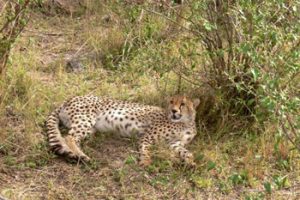 There are other hunters and predators too. The Masai Mara has the second highest lion density in the world with 500 lions in 1500 square kilometers. Thousands of animals are taken by them and by other predators: leopards, cheetah and hyenas – the latter being serious hunters, not just the scavengers they once were. That said, thousands of animals do cross safely and the statistics for a “good” year say 1.5 million cross safely.
There are other hunters and predators too. The Masai Mara has the second highest lion density in the world with 500 lions in 1500 square kilometers. Thousands of animals are taken by them and by other predators: leopards, cheetah and hyenas – the latter being serious hunters, not just the scavengers they once were. That said, thousands of animals do cross safely and the statistics for a “good” year say 1.5 million cross safely.
Further along the route of migration, from the roof of our van, I photograph an intriguing face off. A lion family had apparently killed a migrating zebra and sits near the prey. But with huge ears sticking out menacingly, a matriarch elephant protects the dead zebra, so the lions sit well away from the kill, as though waving a white flag. The knowledgeable van driver guide cannot explain this confrontation. The vegetarian elephant herd would not be interested in the kill for food. There is no known affinity between zebras and elephants. What does the matriarch with her long tusks expect to accomplish by coming between the lion and his prey?
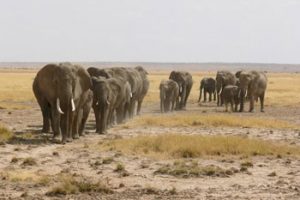 The whole drama unfolds in leisurely fashion. It is an unhurried face off where one lion, then another, rises and ambles along near the kill, but is under the elephant’s watchful eye. The lion walks right past the dead zebra, turns round to face the kill, and sits down, as the elephant keeps an eye on him. It is near a swamp and while the drama unfolds, there are more photo opportunities with the birds: Egyptian geese, plovers, egrets, jacanas rise from the muddy environs, sometimes circle around and descend to continue preening and feeding.
The whole drama unfolds in leisurely fashion. It is an unhurried face off where one lion, then another, rises and ambles along near the kill, but is under the elephant’s watchful eye. The lion walks right past the dead zebra, turns round to face the kill, and sits down, as the elephant keeps an eye on him. It is near a swamp and while the drama unfolds, there are more photo opportunities with the birds: Egyptian geese, plovers, egrets, jacanas rise from the muddy environs, sometimes circle around and descend to continue preening and feeding.
After an interminable half an hour, the duel ends, with the lions strolling away as the matriarch watches. The elephant herd then crosses the dirt road, just twelve feet in front of our van.
“We don’t do anything to the elephants, so they don’t do anything to us, you take photo” whispers the van driver guide.
Many of my shots of those dozen massive pachyderms passing so close to me are useless because of a camera shake in my nervous hands. Soon, the spotted hyenas are moving in from afar, to claim their share of the killed zebra.
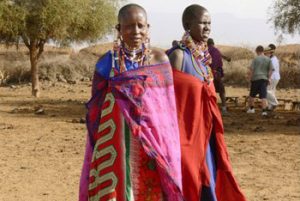 Wanting a better angle for my camera, I open the door to alight from the van. The van driver guard promptly stops me: it is against the law to get off the van when one is inside the park. The only humans that break this law are the Masai tribe members, who nonchalantly roam about on foot in the game park, grazing their cattle. Though they don’t hunt for food, these tall handsome tribesmen are capable of defending themselves with spear and club.
Wanting a better angle for my camera, I open the door to alight from the van. The van driver guard promptly stops me: it is against the law to get off the van when one is inside the park. The only humans that break this law are the Masai tribe members, who nonchalantly roam about on foot in the game park, grazing their cattle. Though they don’t hunt for food, these tall handsome tribesmen are capable of defending themselves with spear and club.
The Masai are yet another plus for me over the TV channels’ enthralling footage. The van driver guide fixes a fee with them and they welcome me at their Masai village with a welcome drink of cow’s blood and cow’s milk (half and half). I am too squeamish to accept the drink. They show how they light a fire using sticks, try to sell trinkets and bangles that they have handcrafted, and do a group dance with the tall handsome men leaping straight upward. Some speak English and joke how the very tall leader is a giraffe. “No”, I say, pointing to his goatee: “He is a goat!”
Everyone bursts out laughing.
“Ok,” concludes the genial leader with a grin, “I am … a … goat giraffe.”
Back home in Bangalore this charming anecdote amuses my family and friends: making a spear wielding ferocious Masai leader admit to being a “goat giraffe.”
If You Go:
The main city is Nairobi.
Amboseli is 120 miles from Nairobi and the usual route is via Namanga. The other route is via Emali on the Nairobi-Mombasa road.
The Masai Mara lies about lies 160 miles from Nairobi (5 hours by road). There are scheduled flights from Wilson Airport, Nairobi, which take about 40 minutes.
Hire a private vehicle to go around the park, or book an organized safari.
Accommodations:
Lodging is available in luxury tents within the reserves (you can even pitch your own as a cheaper option.) There are several hotels around the parks, too.
Best time to visit:
The dry season from July to March is the best time to see wildlife, and the migration occurs in August.
For more information:
Kenya travel details on Wikitravel
Kenya Safari Package to Amboseli National Park for 2 days
About the author:
Arun Bhatia is a 73 year old freelance writer/photographer. He began in freshman year as a cub reporter at U.C.L.A. in 1953, contributing to dailies, weeklies, monthlies etc. in India and elsewhere. Working as senior model in ads/adfilms, willing to make whatever monkey faces at the camera as directed, as long as they paid modeling fees. He rides a 10 year old gearless Honda scooter, grumbles about traffic choked Bangalore roads, and does yoga/pranayama regularly.
Photo credits:
All photos are by Arun Bhatia.




Leave a Reply
You must be logged in to post a comment.